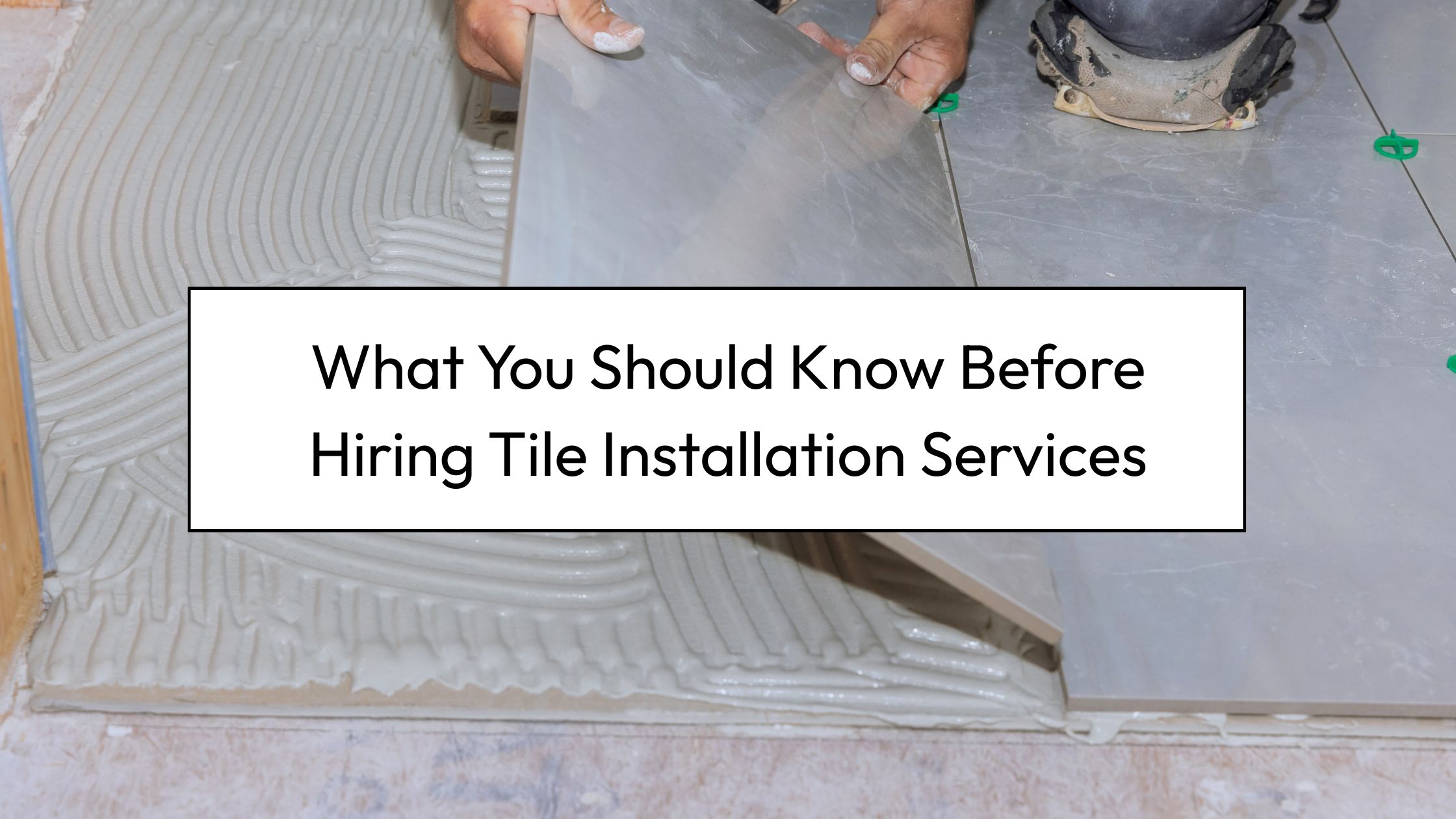Key Takeaways
What should I know before hiring tile installation services?
Before hiring a tile installer, know your tile types, ensure proper surface preparation, ask for contractor credentials, and prioritize precision installation and maintenance.
Tile remains a versatile and durable option for floors and walls, with styles that complement nearly every type of interior. Whether you’re redoing your kitchen or upgrading a bathroom, hiring a qualified tile installer is one of the most important decisions you’ll make for the outcome of your renovation.
Understanding Tile Types
Choosing the right tile can influence not only the visual style of a room but also its durability and maintenance requirements.
Ceramic and Porcelain
Ceramic tiles work well in light-use areas like powder rooms and laundry spaces. They’re widely available in various colors and designs, making them suitable for homeowners looking for affordable yet stylish choices.
Porcelain tiles, known for their density and resistance to water, are better suited for areas exposed to moisture, such as bathrooms, kitchens, and mudrooms. They often imitate the appearance of stone or wood, offering both function and visual appeal.
Natural Stone
Marble, slate, and travertine tiles offer a distinctive look with natural variations in color and veining. These tiles bring a refined character to formal spaces or feature walls but may need periodic sealing due to their porosity.
Glass and Mosaic
Used for backsplashes, accent walls, or decorative inserts, glass and mosaic tiles create a bright, modern aesthetic. Their smaller size and fragility require experienced handling and precise installation.
Preparation is More Than Surface-Level
Good tile work depends on what lies beneath. Before installation begins, thorough preparation helps avoid common issues that shorten the lifespan of your flooring or wall surface.
Surface Evaluation
Professional installers inspect the floor or wall for inconsistencies, such as dips, cracks, or uneven areas. These issues need to be corrected to achieve a level, stable base.
Moisture and Structure Checks
Moisture intrusion is a common concern in tiling projects. Installers should address any structural concerns or dampness before proceeding to avoid long-term problems like mildew or shifting tiles.
Proper Underlayment
Using an appropriate underlayment, such as cement board or waterproof membranes, supports the tiles and protects against moisture. Skipping this step risks cracking, loose tiles, and grout deterioration.
Installation Techniques That Make a Difference
Even the best tile will look flawed if installed improperly. A skilled contractor uses proven techniques and attention to detail to create a seamless result.
Leveling and Spacing
A level surface eliminates uneven edges, often referred to as lippage. Installers use spacers and leveling systems to achieve consistent tile height and clean alignment.
Grouting and Sealing
Properly spaced and sealed grout lines enhance the visual appeal and safeguard against water intrusion. Choosing the right grout color and type contributes to the overall look of the tilework and supports long-term durability.
Precision Cuts
From trimming tiles to fit corners to aligning patterns symmetrically, professional cutting and placement bring polish to the final result. These steps require the right tools and a steady hand, which experienced tilers consistently provide.
What to Look for in a Tile Contractor
Choosing a reliable tile installer means doing a bit of research. Here are some ways to find a dependable professional:
- Ask for reviews or testimonials from past clients. This feedback helps reveal patterns in workmanship and communication.
- Look through photo galleries or portfolios to assess the types of projects the contractor has completed.
- Confirm that the contractor is licensed and insured. This protects your home and gives peace of mind in case of accidents.
- Request a detailed estimate. This should outline labor, materials, and an estimated timeline so you understand exactly what you’re agreeing to.
Working with a local company like Creative Floors and Designs also brings the advantage of regional experience. Local professionals are familiar with neighborhood preferences, common construction methods, and permitting requirements across Northern New Jersey.
Maintaining Your Tile After Installation
Proper care keeps tiles looking new and functioning well for years.
Regular Cleaning
Sweep or vacuum often to keep abrasive dirt and debris from scratching the surface. Use a soft mop and tile-safe, pH-neutral cleaner to refresh the area without damaging finishes.
Grout Attention
Grout lines can become dingy or stained if not properly cared for. A mild cleaner and soft brush can keep them clean, while resealing every year or two protects against water damage and discoloration.
Spill Management
Especially with natural stone, it’s best to wipe up spills promptly. Acidic liquids like vinegar or juice can leave marks if allowed to sit.
Ready to Start?
Installing tile is a worthwhile upgrade, and choosing professionals who take pride in their work makes a noticeable difference. At Creative Floors and Designs, our team brings precision and care to every project. From material selection to the final sealant, we aim for excellence at every step.
Serving homes throughout Northern New Jersey, we provide clear communication, timely service, and attention to the smallest details. Whether you’re remodeling a bathroom, updating a kitchen, or planning a larger renovation, our experienced tilers are ready to help.
Contact Creative Floors and Designs to schedule a consultation. We’ll help bring your ideas into reality with clean lines, beautiful finishes, and lasting results.
FAQ
What is the difference between ceramic and porcelain tiles?
Ceramic tiles are great for light-use areas and come in many styles, while porcelain is denser, more water-resistant, and better for high-moisture spaces like bathrooms and kitchens.
How important is surface preparation before tile installation?
Extremely important. Proper prep prevents issues like uneven surfaces, cracks, and moisture damage ensuring your tile lasts longer and looks better.
What should I look for in a tile installation contractor?
Look for contractors with positive reviews, a strong portfolio, proper licensing and insurance, and detailed written estimates that outline labor, materials, and timelines.
How do I maintain my tile after installation?
Clean regularly with a soft mop and pH-neutral cleaner, keep grout lines sealed, and quickly clean spills, especially on natural stone, to avoid damage.
Why should I consider a local tile installer?
Local professionals understand regional building styles, permitting requirements, and climate-related concerns ensuring a smoother and more personalized experience.






